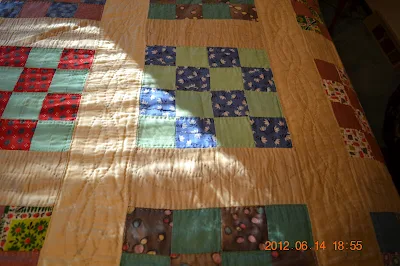 |
| This is a large quilt. It covers a queen bed and has a full row plus drape on each side and one row is tucked in at the foot. I think this is the largest quilt they made. |
 |
| 16 patch |
 |
| the borders and sashing strips are a type of polished cotton |
 |
| pencil marks, there to stay |
That took the thought process to all those quilts in antique shops, in yard sales etc. Many sellers have no idea how much work and talent are required to create these masterpieces. No, not all are perfect. Yes, many are made from re-used fabrics. There are no famous names attached. To overhear comments at garage sales that this one will be cut up for this or that actually requires me to intrude and voice opinions. (I try to be helpful, informative and certainly not rude. ) Of course, some are beyond repair and their useful parts should be repurposed.
Ann Wasserman is an expert in quilt care and restoration. Her website provides answers to all of us to make/collect quilts. This page gives you guidelines that may help in your decision about that "vintage" quilt you have been holding on to. Recent magazine articles in home and garden periodicals tout the advantages of cutting up old quilts to make decorator pillows. While this is an option for a terribly worn or damaged piece, there are times to reconsider the current decorating trend to preserve history.
http://www.annquilts.com/quiltrepair.html
Ann's Blog
*tip, keep scraps of the fabrics used in making your quilt in a ziplock bag and give to the owner or keep them yourself for repairs.
Gratuity Moment: persons who work very hard to guide us in decisions like this and share their expertise willingly.
Comments